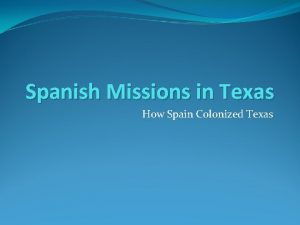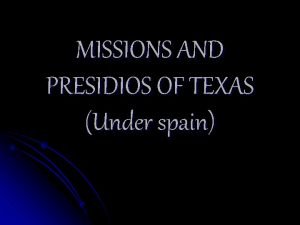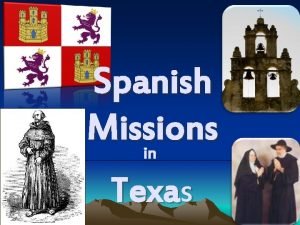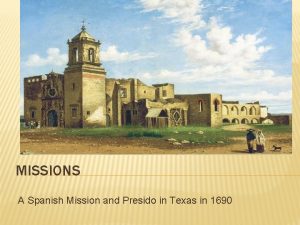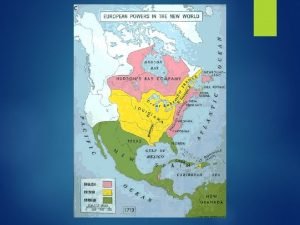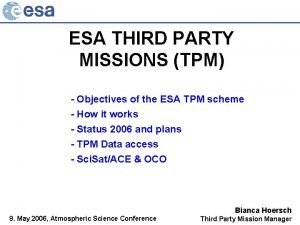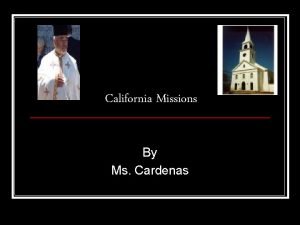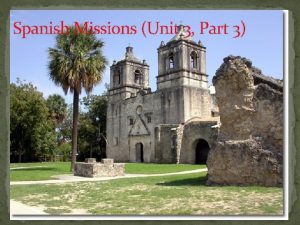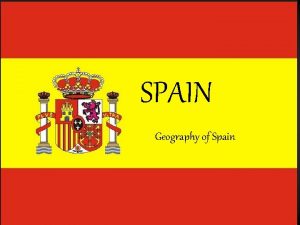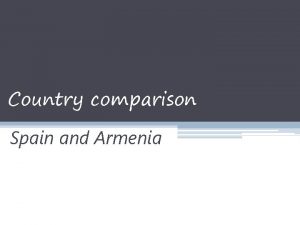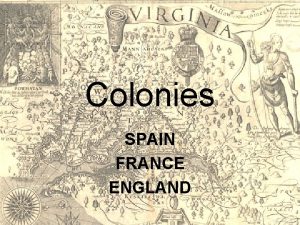Spanish Missions Unit 2 Part 3 Spain Looks












- Slides: 12

Spanish Missions (Unit 2, Part 3)

Spain Looks to Texas In 1682 Spanish friars founded the first permanent settlement of Europeans in Texas —the mission Corpus Christi de la Ysleta near El Paso. New Spain starts colonizing Texas with the mission system.

Spanish Colonization: Missions & Presidios Missions…were Spain’s main way of colonizing and were expected to support themselves. The first missions were established in the El Paso area, then East Texas and finally in the San Antonio area. Missions were used to convert the Natives to the Catholic faith and make loyal subjects to Spain. Presidios were built nearby to house soldiers and protect the mission and townspeople.

Spanish Colonization: Towns & Ranches Towns and settlements were built near the missions and colonists were brought in for colonies to grow and survive. The first group of colonists to establish a community was the Canary Islanders in San Antonio (1730). Ranches were more conducive to where missions and settlements were thriving (San Antonio). Cattle was easier to raise and protect than farming.

La Salle’s Legacy Spanish officials learned of La Salle's fort in Texas soon after it was built. They immediately sent troops led by Alonso de León, the governor of Coahuila, to destroy it. He reached the site on April 22, 1689, only to find the fort deserted and in ruins.

Spain Meets “Tejas” De León then led his troops northeast. Near the Colorado River, they met a large group of Hasinai people, whom they called the Tejas, a word meaning "friend. " Angelina, a Hasinai woman, served as guide and interpreter.

San Francisco de los Tejas (1690) Fray Damián Massanet, a Catholic priest, promised he would return to help the Hasanai and Caddo people. He and 3 other friars, and about 100 soldiers return to establish the first Spanish mission in East Texas named San Francisco de los Tejas in near Weches.

A Mission Abandoned The mission failed because crops failed, disease killed many natives, and the Tejas rejected the Catholic religion. But the experiment will strengthen Spain’s claim to Texas.

San Juan Bautista (1699) From 1693 to 1714, Spain made no effort to settle Texas. But their settlements along the Rio Grande flourished. Mission San Juan Bautista along the Rio Grande was called the "Mother of Texas Missions" because it was the base for many expeditions whose aims were to establish missions in East Texas. It provided grain, cattle, and horses to the missionaries on these expeditions.

Spain vs. France French not interested in taking territory or converting the Native Americans to Catholicism. French traders won the friendship of many Native groups, and the French made large profits exchanging blankets, guns, and wine for furs and skins. The French also hoped to trade with Spanish merchants in Mexico, but Spanish law prohibited foreigners from trading in the colonies of New Spain. Spanish- all about God, Gold, Glory

France Threatens Again A Spanish priest named Francisco Hidalgo asks French Catholic priests to help create a mission in East Texas because the Spanish will not. The unexpected arrival of the French party led by Louis de St. Denis alarmed Captain Diego Ramón, the presidio's commander. He arrested St. Denis and sent him to Mexico City to be examined by the viceroy. St. Denis insisted that France had no plans to occupy East Texas.

France Threatens Again The Spanish viceroy and his council, or advisers, did not believe St. Denis. They ordered new missions to be built in East Texas with Spanish soldiers to protect them. Trade between the Spanish and French was stopped.
 Why did the spanish establish missions in texas
Why did the spanish establish missions in texas Spanish missions in texas map
Spanish missions in texas map Why did the spanish build missions in texas?
Why did the spanish build missions in texas? Spanish missions in georgia
Spanish missions in georgia Spanish missions in texas
Spanish missions in texas What he looks like or how he looks like
What he looks like or how he looks like What does he look like
What does he look like Missions and presidios
Missions and presidios Esa and jj
Esa and jj Critical missions swat
Critical missions swat California missions map
California missions map Southern california missions map
Southern california missions map What are the 21 missions in order
What are the 21 missions in order
